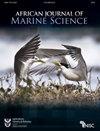Wind- and eddy-driven upwelling over submarine canyons inshore of the northern Agulhas Current
IF 1.4
4区 生物学
Q3 MARINE & FRESHWATER BIOLOGY
引用次数: 1
Abstract
The iSimangaliso Wetland Park, located along the coastline of northern KwaZulu-Natal, hosts South Africa’s only subtropical coral reef system. Episodic upwelling events are observed inshore and at the heads of Diepgat, Leadsman and Leven canyons within the iSimangaliso Wetland Park and may assist in larval dispersal and act as a buffer against coral bleaching. Over a 12-month period (1 June 2018-31 May 2019), two cooling events were identified from surface and subsurface temperature measurements extracted from the Sea Surface Temperature (SST) product of the Operational Sea Surface Temperature and Ice Analysis (OSTIA) satellite and data collected from underwater temperature recorders, respectively. Lagged correlations between subsurface temperatures confirmed that the anomalous cooling events were upwelling events (of 2-7 hours). The approximate upwelling rate was greatest at Diepgat Canyon, which suggests that upwelling events are enhanced by the physical structure of the canyon head and its shallow termination point which may influence the affected ecosystems. Wind measurements from the Mbazwana weather station and satellite sea-level anomalies were used to investigate the respective roles of wind stress and mesoscale ocean variability as driving forces of the upwelling events. The results indicate that the less intense and shorter cooling event was driven by a cyclonic eddy event, but that the stronger cooling event was driven by a combination of both forcing mechanisms.阿古拉斯洋流北部近海海底峡谷上空的风和涡驱动上升流
iSimangaliso湿地公园位于夸祖鲁-纳塔尔北部海岸线,拥有南非唯一的亚热带珊瑚礁系统。在iSimangaliso湿地公园内的Diepgat、Leadsman和Leven峡谷的近海和顶部观察到偶发性上升流事件,可能有助于幼虫的扩散,并起到防止珊瑚白化的缓冲作用。在12个月的时间里(2018年6月1日至2019年5月31日),分别从操作海面温度和冰分析(OSTIA)卫星的海面温度(SST)产品中提取的表面和地下温度测量值以及从水下温度记录器中收集的数据中确定了两次冷却事件。地下温度之间的滞后相关性证实了异常冷却事件是上升流事件(2-7 小时)。Diepgat峡谷的近似上升流速率最大,这表明上升流事件因峡谷顶部及其浅终止点的物理结构而增强,这可能会影响受影响的生态系统。姆巴兹瓦纳气象站的风力测量和卫星海平面异常被用来研究风应力和中尺度海洋变化作为上升流事件驱动力的各自作用。结果表明,强度较小和较短的冷却事件是由气旋涡事件驱动的,但较强的冷却事件则是由两种强迫机制的结合驱动的。
本文章由计算机程序翻译,如有差异,请以英文原文为准。
求助全文
约1分钟内获得全文
求助全文
来源期刊

African Journal of Marine Science
生物-海洋与淡水生物学
CiteScore
2.60
自引率
16.70%
发文量
17
审稿时长
6-12 weeks
期刊介绍:
The African (formerly South African) Journal of Marine Science provides an international forum for the publication of original scientific contributions or critical reviews, involving oceanic, shelf or estuarine waters, inclusive of oceanography, studies of organisms and their habitats, and aquaculture. Papers on the conservation and management of living resources, relevant social science and governance, or new techniques, are all welcomed, as are those that integrate different disciplines. Priority will be given to rigorous, question-driven research, rather than descriptive research. Contributions from African waters, including the Southern Ocean, are particularly encouraged, although not to the exclusion of those from elsewhere that have relevance to the African context. Submissions may take the form of a paper or a short communication. The journal aims to achieve a balanced representation of subject areas but also publishes proceedings of symposia in dedicated issues, as well as guest-edited suites on thematic topics in regular issues.
 求助内容:
求助内容: 应助结果提醒方式:
应助结果提醒方式:


